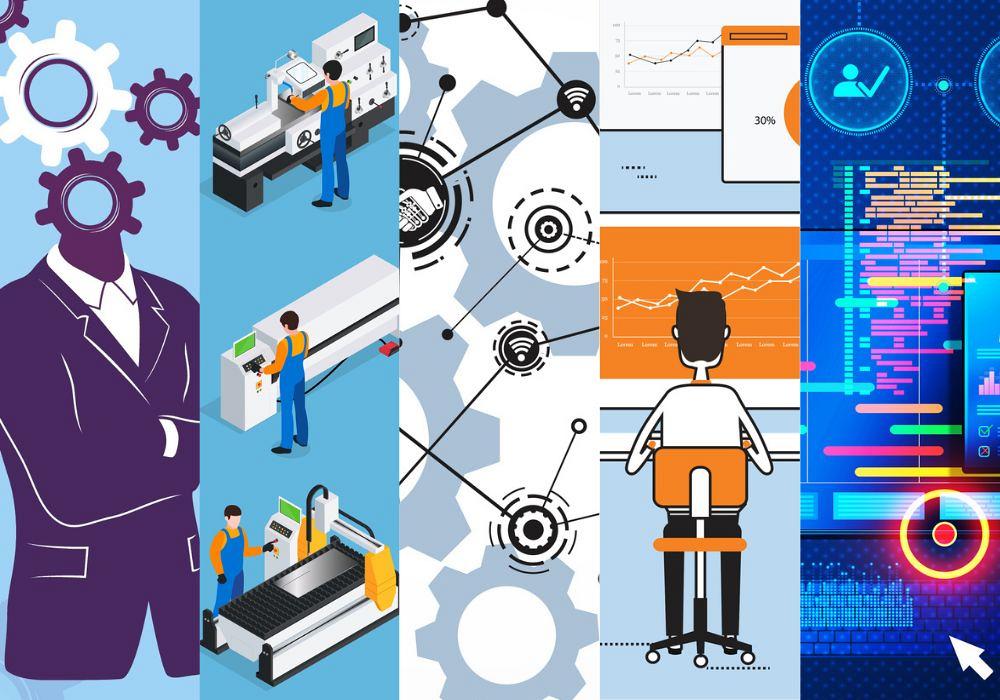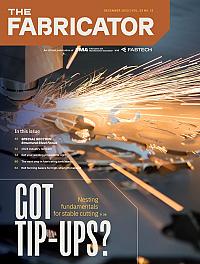Senior Editor
- FMA
- The Fabricator
- FABTECH
- Canadian Metalworking
Categories
- Additive Manufacturing
- Aluminum Welding
- Arc Welding
- Assembly and Joining
- Automation and Robotics
- Bending and Forming
- Consumables
- Cutting and Weld Prep
- Electric Vehicles
- En Español
- Finishing
- Hydroforming
- Laser Cutting
- Laser Welding
- Machining
- Manufacturing Software
- Materials Handling
- Metals/Materials
- Oxyfuel Cutting
- Plasma Cutting
- Power Tools
- Punching and Other Holemaking
- Roll Forming
- Safety
- Sawing
- Shearing
- Shop Management
- Testing and Measuring
- Tube and Pipe Fabrication
- Tube and Pipe Production
- Waterjet Cutting
Industry Directory
Webcasts
Podcasts
FAB 40
Advertise
Subscribe
Account Login
Search
5 metal fabrication trends for 2024
A generational transition continues in the manufacturing sector
- By Tim Heston
- December 17, 2023

It’s a complicated time. The industry faces wage pressures and a skills gap, but metal fabrication technology continues to march forth faster than ever. Getty Images Plus
This year, I’ve spoken to people who’ve talked at length about the potential of data, software, machine learning, and artificial intelligence (AI). I’ve also spoken to people who’ve dealt with press brake departments full of rookies who don’t know the fundamentals. I’ve heard of wage pressures and poaching, of ever-increasing opportunities thanks to reshoring. It’s a time of transition, tumult, and technological marvels. Moving ahead to 2024, what can we expect?
1. New Leaders Embrace Technology and Talent
Boomers can’t work forever, and their kids came of age during an era of offshoring and the Great Recession. Successful custom fabricators are now looking for buyers, and interest remains for businesses with good data, a deep bench of talent, and a diverse customer base in sustainable industries with good futures. Very small shops that lack this, or for whatever reason can’t find a suitable buyer, might be shutting their doors and putting their assets (including a lot of used machinery) up for sale. Those who have all three—and particularly a deep bench of talent—might find buyers willing to pay top dollar, even in the current interest rate environment.
2. The Successful Shops Make Time for Technical Learning
This applies to teaching the fundamentals of cutting, bending, and welding, of course, but it also applies to learning what today’s technology is truly capable of. Earlier this year, I visited Cupples’ J&J Co. Inc., a large custom fabricator based in Jackson, Tenn., and saw a team making test cuts in thick plate with an ultrahigh-powered fiber laser. The shop’s known for pushing the technical envelope, and I was witnessing that “pushing” firsthand.
3. Good Processes Allow for Controlled Creativity
Having good procedures around process development helps everyone know “the why” behind certain decisions. This year, I spoke with press brake experts who told me how they visited bending departments full of rookies. None of them really knew the basics of air bending. They followed a specific process and chose certain tooling just because that’s what they were told to do, even though they were getting less-than-desirable results. When a shop has its procedures under control, everyone knows why they work the way they do. In so doing, they can (during designated times and with the right authorization) test alternatives, develop new ways to form (or cut or weld), document what they find, and ultimately make a fabricator more competitive.
4. Shops Automate for Flow and Predictability
When I visit a shop with automated part sorting, be it from a punch (which is more common) or a laser, the fabricators who made those technology investments rarely do it for the raw speed of the system itself. They invest in part sorting because it’s predictable. Planners know exactly how long the system will take to sort and stack. Manual denesters could do it faster—but they could also do it slower. And let’s face it, few want to spend a career shaking parts from skeletons or hammering out parts from plate.
The same could be said for any number of processes between operations. A cut blank might be automatically picked, sorted, and stacked, ready for the fork truck driver—but what happens when there’s no fork truck drivers? Here, automated guided vehicles (AGVs) and autonomous mobile robots (AMRs) might start filling a need at more operations. They won’t be pervasive in 2024, but I’m sure more fabricators will start thinking about them—along with any other way to automate those tedious fabrication steps in between work centers.
5. Good Data Will Matter More
Fab shop buyers today look for well-documented data and information management, and there’s a good reason for that. So many headaches come from nonstandardized data entry. This applies to anything from part numbers to inventory locations. Progressive shops today are investing in software that eases information management. This includes not just ERP but also production control, programming, and IIoT platforms that track machinery and other asset performance.
Yes, fancy software can’t be used as a Band-Aid over poor training or procedures. But the latest software is also helping to streamline order processing in a dramatic way. A four-week lead time is a snail’s pace for some quick-turn shops.
More than that, good data will help pave the way for a future that’s rich in machine learning and artificial intelligence. AI hasn’t changed the industry yet, and it probably won’t in 2024, but that day is coming.
subscribe now

The Fabricator is North America's leading magazine for the metal forming and fabricating industry. The magazine delivers the news, technical articles, and case histories that enable fabricators to do their jobs more efficiently. The Fabricator has served the industry since 1970.
start your free subscriptionAbout the Author

Tim Heston
2135 Point Blvd
Elgin, IL 60123
815-381-1314
Tim Heston, The Fabricator's senior editor, has covered the metal fabrication industry since 1998, starting his career at the American Welding Society's Welding Journal. Since then he has covered the full range of metal fabrication processes, from stamping, bending, and cutting to grinding and polishing. He joined The Fabricator's staff in October 2007.
- Stay connected from anywhere

Easily access valuable industry resources now with full access to the digital edition of The Fabricator.

Easily access valuable industry resources now with full access to the digital edition of The Welder.

Easily access valuable industry resources now with full access to the digital edition of The Tube and Pipe Journal.
- Podcasting
- Podcast:
- The Fabricator Podcast
- Published:
- 04/16/2024
- Running Time:
- 63:29
In this episode of The Fabricator Podcast, Caleb Chamberlain, co-founder and CEO of OSH Cut, discusses his company’s...
- Trending Articles
Tips for creating sheet metal tubes with perforations

JM Steel triples capacity for solar energy projects at Pennsylvania facility

Are two heads better than one in fiber laser cutting?

Supporting the metal fabricating industry through FMA

Omco Solar opens second Alabama manufacturing facility

- Industry Events
16th Annual Safety Conference
- April 30 - May 1, 2024
- Elgin,
Pipe and Tube Conference
- May 21 - 22, 2024
- Omaha, NE
World-Class Roll Forming Workshop
- June 5 - 6, 2024
- Louisville, KY
Advanced Laser Application Workshop
- June 25 - 27, 2024
- Novi, MI


























